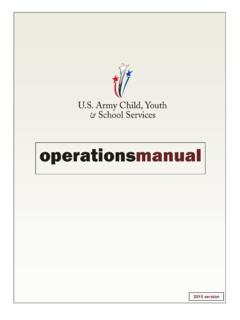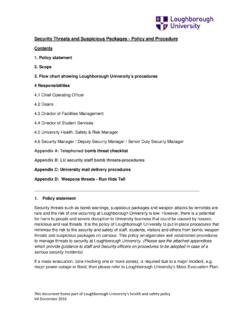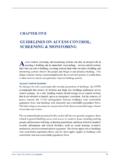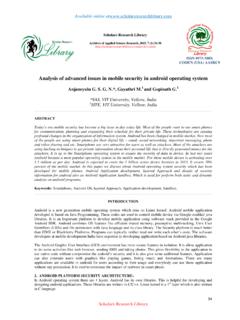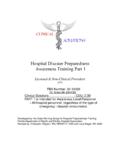Transcription of THE iWATCH INITIATIVE - cyssprogram.com
1 iWATCH , OPSEC and Information security Awareness TrainingObjectivesFollowing completion of this module, participants will be able to: Develop a greater understanding of the iWATCH INITIATIVE and their roles as contractors working in a government facility Develop a greater awareness of OPSEC and the identified strategies for properly securing and maintaining personal information on Child and Youth Program participants Identifying the best strategies for safe-guarding government equipment, information and reportsTHE iWATCH INITIATIVE The iWATCH InitiativeAs a result of recent attacks and breeches from outside sources to obtain confidential government information, the Army implemented the iWATCH INITIATIVE .
2 iWATCH is a national campaign designed to increase awareness and understanding of indicators of potential terrorism or terrorism-related slogan for the INITIATIVE is: If You See Something, Say Something Facts About the iWATCH INITIATIVE iWATCH was first developed by the Los Angeles Police Department as a means of encouraging citizens to engage in safe-guarding their community iWATCH was first revealed in October 2009 by Los Angeles Police Chief William BrattonAs Bratton stated, [ iWATCH ] is intended to be the next evolution ofkeeping America safe.
3 Activities to Report Use Your SensesTo help simplify the reporting process, the following guidelines were developed:If it does not LOOK right, report itIf it does not SMELL right, report itIf it does not SOUND right, report itCitizens are encouraged to report activities they deem to be suspicious and let the proper authorities determine if a terrorism-related threat exists. Citizen are not expected to be experts in identifying terrorism, nor are they expected to handle the situation themselves leave that to the trained of suspicious Activities Unfamiliar individuals sketching or taking picture of specific building layouts Unfamiliar individuals asking in-depth questions related to security forces and/or operations Packages or other unfamiliar items left unattended in buildings and/or vehicles Unattended vehicles parked in locations typically unoccupied by motorized vehicles Unauthorized personnel in restricted areas Chemical smells or visible powders
4 Left in areas An unfamiliar individual asking in-depth questions about building blueprints, where specific items are stored or schedules for invited guestsWhile this list is not inclusive of all suspicious activities and/or behaviors, it does highlight some of the more common items which warrant reporting to the proper Needed When Making A ReportThe more information and details you can provide the reporting officials, the more likely they will be able to intervene effectively. Some of the information you should try to provide includes: The date and time of the observed activity/behavior The location of the observed activity/behavior The actions/behaviors you observed by the individual(s) An overall description of the individual(s).
5 Gender Height Weight Hair and skin color Approximate age Description of their vehicle (make and model, color and license plate numberAreas and Facilities to MonitorWhile terrorism-related attacks can happen at any time and in any location, the following areas and facilities are the most commonly targeted: Joint Forces Headquarters (JFHQ) Installation/Base security check points Barracks and other lodging facilities Commissaries, PXs and other regularly populated facilities Sporting and entertainment venues Recreational facilities/centers Schools.)
6 Libraries and child care centers Hospitals and other care facilities Various modes of public transportation Areas with large gatherings of peopleMaking A ReportEach installation/base and public facility will have standard operating procedures established which detail the proper steps for making a report of suspicious activities/behaviors. If you are unfamiliar with those procedures, complete the following contact the security and/or military police dispatch for the installation/base where you are the local law enforcement agency and explain the situation they can provide additional guidance over the phone until personnel it is an emergency, immediately call 911 and then work to ensure the safety of those around you/entrusted to you OPSECOPERATIONS SECURITYWhat is OPSEC?
7 OPSEC is defined process that identifies critical information to determine if friendly actions can be observed by enemy intelligence, determines if information obtained by adversaries could be interpreted to be useful to them, and then executes selected measures that eliminate or reduce adversary exploitation of friendly critical purpose does OPSEC serve?In an ever-changing world of technology, where more and more individuals exchange information via digital systems, potential access points by criminals/hackers working to obtain confidential information become increasingly contractors working in a government facility, and handling personal information on Service Members and their families.
8 It is our responsibility to ensure all actions are taken to protect and safe-guard that must always err on the side of being overly cautious and protective of all information entrusted to us or that we have access AttacksThe statistics surrounding the occurrence of digital/cyber attacks are staggering. The CNN news network released the following statistics: Nearly 1 million new malware threats are released each day, all designed to gain access to personal information It is estimated 20 million cyber attacks happen each day around the world According to some studies, it is estimated 5,000 cyber attacks happen each hour in the United StatesRemaining diligent in our efforts to protect information is critical in the government AttacksThe statistics surrounding the occurrence of digital/cyber attacks are staggering.
9 The CNN news network released the following statistics: Nearly 1 million new malware threats are released each day, all designed to gain access to personal information It is estimated 20 million cyber attacks happen each day around the world According to some studies, it is estimated 5,000 cyber attacks happen each hour in the United StatesRemaining diligent in our efforts to protect information is critical in the government Word of WarningIn a statement recently released from former CIA Director, George The number of known adversaries conducting research oninformation attacks is increasing rapidly and includes intelligence services, criminals, industrial competitors, hackers and aggravated and/or disloyal insiders.
10 OPSEC IndicatorsWhen learning about or talking to individuals about OPSEC, you may hear the phrase OPSEC Indicator being used. What is an OPSEC Indicator?At its core, an OPSEC Indicator is a piece of information hackers or terrorism-related entities can exploit to gain access to personal and confidential information on Service Members, family members, business and organizations (like the National Guard, Army and Department of Defense).The 5 Steps of OPSECD etermining critical information, and then protecting that information, is the core of OPSEC.
